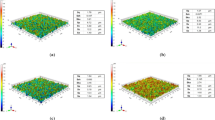Abstract
Virtual simulation and optimization of the dynamic behavior of machine tools in the development phase is required to satisfy the increasing demands on machine tool performance. While mass and stiffness properties can be simulated with sufficient accuracy, often no suitable damping models are available for the components of machine tools. The commonly used linear damping models are predominantly linear hysteretic or viscous models. However, the linear damping models are often not appropriate to reflect the occurring nonlinear effects in machine tools with the required accuracy. The reason for these nonlinearities are predominantly the friction forces in feed drive components. To resolve these deficits, the friction in feed drive components is comprehensively investigated in this paper, models for friction forces are identified and coupled with a reduced, flexible multi-body system. With the identified friction models the measured friction curves can be reproduced very precisely. The coupled, reduced, flexible multi-body model allows to simulate the nonlinear effects and to predict the dynamic behavior of machine tools with high accuracy. Consequently, a further important step towards accurate virtual simulation of machine tools is made.












Similar content being viewed by others
References
Altintas Y, Brecher C, Weck M, Witt S (2005) Virtual machine tool. CIRP Ann Manuf Technol 54(2):115–138
Weule H, Albers A, Haberkern A, Neithardt W, Emmrich D (2002) Computer aided optimisation of the static and dynamic properties of parallel kinematics. In: Proceedings of the 3rd Chemnitz parallel kinematic seminar, p 527–546
Oertli T (2008) Strukturmechanische Berechnung und Regelungssimulation von Werkzeugmaschinen mit elektromechanischen Vorschubantrieben. No. 216 in Forschungsberichte IWB, Herbert Utz, Munich
Queins M (2005) Simulation des dynamischen Verhaltens von Werkzeugmaschinen mit Hilfe flexibler Mehrkoerpermodelle. No. 12/2005 in Ergebnisse aus der Produktionstechnik, Shaker, Aachen
Siedl DJ (2008) Simulation des dynamischen Verhaltens von Werkzeugmaschinen waehrend Verfahrbewegungen. No. 213 in Forschungsberichte IWB, Herbert Utz, Munich
Gawronski WK (2004) Advanced structural dynamics and active control of structures. Springer, Berlin
Adhikari S (2000) Damping models for structural vibration. Dissertation University of Cambridge
Rayleigh JWS (1877) The theory of sound (two volumes). Macmillan, London
Groche P, Hofmann T (2005) A new method to determine the dynamic properties of profiled guideways and guide slide bearings. Prod Eng Res Devel 12:187–190
Brecher C, Fey M, Baeumler S (2013) Damping models for machine tool components of linear axes. CIRP Ann Manuf Technol 62:399–402
Ewins DJ (1984) Modal testing: theory and practice. Research Studies Press Ltd, Taunton
Varanasi KK, Nayfeh SA (2004) The dynamics of lead-screw drives: low-order modeling and experiments. J Dyn Syst Meas Control 126:388–396
MSCSoftware Corporation (2011) MD Nastran 2011 & MSC Nastran 2011 dynamic analysis user’s guide. 2 MacArthur Place, Santa Ana, CA 92707
Kunc M (2013) Identifikation und Modellierung von nichtlinearen Daempfungseffekten in Vorschubachsen fuer Werkzeugmaschinen. No. 11/2013 in Ergebnisse aus der Produktionstechnik, Apprimus, Aachen
Niehues K, Rebelein C, Zaeh MF (2015) Identification of local damping models of machine tools by a sequential assembling process. In: Proceedings of the 4th international conference on virtual machining process technology, Vancouver
Lampaert V, Swevers J, Al-Bender F (2002) Modification of the leuven integrated friction model structure. IEEE Trans Autom Control 47(4):683–687
Björklund S (1997) A random model for micro-slip between nominally flat surfaces. ASME J Tribol 119:726–732
Dahl PR (1977) Measurement of solid friction parameters of ball bearings. In: Proceedings of symposium on incremental motion control systems and devices, p 49–60
Canudas de Wit C, Olsson H, Aström KJ, Lischinsky P (1995) A new model for control of systems with friction. IEEE Trans Autom Control 40(3):419–425
Armstrong-Hélouvry B (1991) Control of machines with friction. Kluwer, Boston
Swevers J, Al-Bender F, Gansemann CG, Prajogo T (2000) An integrated friction model structure with improved presliding behavior for accurate friction compensation. IEEE Trans Autom Control 45(4):675–686
Fey M (2015) Identifikation geeigneter parametrierter Daempfungsmodelle fuer Komponenten einer Linearachse. Ergebnisse aus der Produktionstechnik, Apprimus, Aachen
Niehues K (2015) Identifikation linearer Daempfungsmodelle fuer Werkzeugmaschinenstrukturen. Forschungsberichte IWB, Herbert Utz, Munich
Craig RR, Bampton MCCC (1968) Coupling of structures for dynamic analyses. AIAA J 6(7):1313–1319
Besselink B, Tabak U, Lutowska A, van de Wouw N, Nijmeijer H, Rixen DJ, Hochstenbach ME, Schilders WHA (2013) A comparison of model reduction techniques from structural dynamics, numerical mathematics and systems and control. J Sound Vib 332:4403–4422
Schwarz S (2015) Prognosefaehigkeit dynamischer Simulationen von Werkzeugmaschinenstrukturen. Forschungsberichte IWB, Herbert Utz, Munich
Okwudire CE, Altintas Y (2009) Hybrid modeling of ball screw drives with coupled axial, torsional and lateral dynamics. ASME J Mech Des 131:071002-1–071002-9
Maia NMM, Silva JMM (1997) Theoretical and experimental modal analysis. Research Studies Press Ltd, Taunton
Schwarz S, Sing A, Zaeh MF (2014) Identification and evaluation of uncertainties and errors in dynamic models of casted machine tool components. Prod Eng Res Devel 8:175–185
Acknowledgments
This work was supported by the German Research Foundation (DFG) within the research unit FOR-1087 “Damping effects in Machine Tools”.
Author information
Authors and Affiliations
Corresponding author
Rights and permissions
About this article
Cite this article
Rebelein, C., Zaeh, M.F. Friction in feed drives of machine tools: investigation, modeling and validation. Prod. Eng. Res. Devel. 10, 497–507 (2016). https://doi.org/10.1007/s11740-016-0678-3
Received:
Accepted:
Published:
Issue Date:
DOI: https://doi.org/10.1007/s11740-016-0678-3




